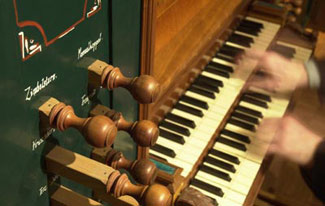|
HOME | SEARCH | ARCHIVE |
|
Hearing history
![]()
 University organist, Davitt Moroney, demonstrates his manual dexterity while performing on the Gallery Organ. Noah Berger photo |
By D. Lyn Hunter, Public Affairs
 |
Flash
slide show (Requires Flash plug-in) |
11 September 2002
|
Berkeley is recognized globally for its outstanding array of priceless holdings,
from Mark Twain letters and Emma Goldman papers to Native American baskets
and dinosaur fossils.
While these artifacts are a wonderful way to see and touch history, they
are, by and large, silent objects. Imagine being able to hear the sounds
of the past.
Faculty, students, and visiting scholars can do just that, thanks to
a world-class collection of 14 antique (and antique-style) pipe organs
acquired by the music department over the past 50 years.
The collection includes several rare antiques, such as an Italian organ
dating from 1750, housed on stage at Hertz Hall, that was recently played
at a noon concert by University Organist Davitt Moroney.
This particular instrument features a unique pumping system, says Moroney,
referring to the bellows on older organs that must be operated manually.
“While it is being played, someone must continually pull out ropes on
the side of the instrument to re-inflate the bellows. Back in those days,
students performed this duty during their teacher’s concerts. It was one
way of paying for lessons!“
Another rare organ, made in Holland in 1783, is housed in an ornate cabinet,
adorned with gilded angel sculptures and intricate paintings of angels
blowing trumpets. It probably originally resided in someone’s home, Moroney
says.
Several organs in the collection are replicas of instruments built in
the 17th and 18th centuries, the “golden era” of organ building.
For example, the Gallery Organ in Hertz Hall was constructed by an American
in 1982 in the 17th-century German style. The Organetto, a small, lap-size
instrument made in 1968, is a replication based on images in medieval
paintings.
“These old or old-style instruments help students imagine the different
ways music sounded in earlier centuries,” says Moroney, stressing the
organs’ pedagogical importance. “Playing music by great composers on instruments
similar to those of their own time gives us a different kind of musical
pleasure today.”
Because of limited storage space, two organs are located off campus.
One, built in 1971 by Jurgen Ahrend, has resided in St. Joseph’s Church
near the corner of Durant Avenue and Bowditch Street for more than 25
years. The other, a magnificent Spanish-style model with giant exterior
bellows and carvings embellished with sparkling gold leaf, is in the chapel
of the Pacific Lutheran Theological Seminary, in the hills above campus.
But Moroney and others in the music department hope to get these treasures
back on campus soon.
“We need to raise money to convert the old Power House, near Sather Gate,
into a small recital hall. The acoustic there is especially good for organ
music,” says Moroney. “Our old instruments are not museum pieces. They
help us to teach, and they also greatly enrich the musical life of the
campus.” Flash slide show
(Requires Flash plug-in)
Home | Search | Archive | About | Contact | More News
Copyright 2002, The Regents of the University of California.
Produced and maintained by the Office of Public Affairs at UC Berkeley.
Comments? E-mail berkeleyan@pa.urel.berkeley.edu.